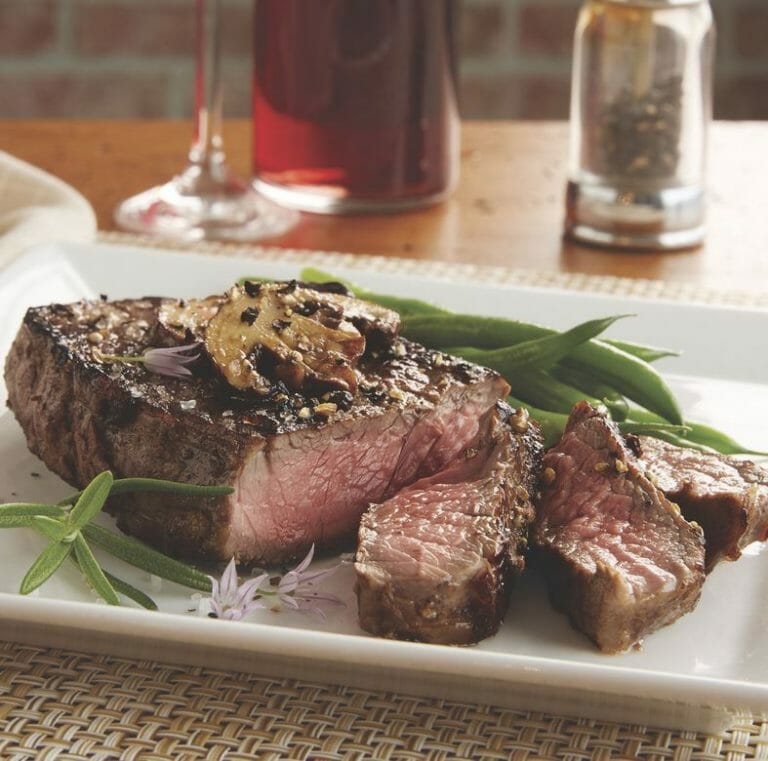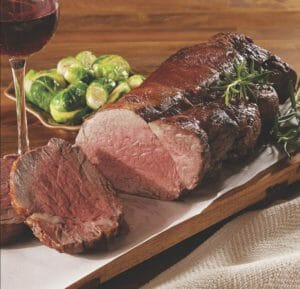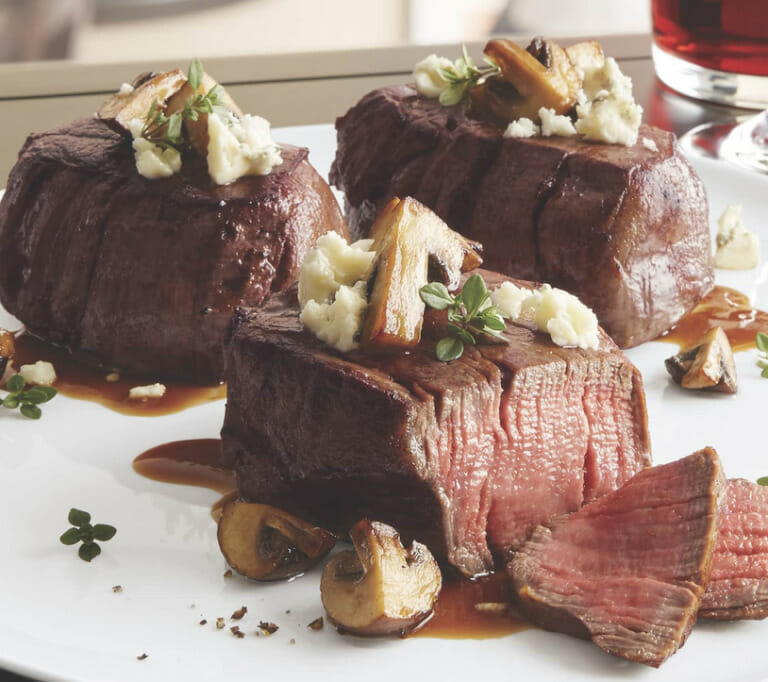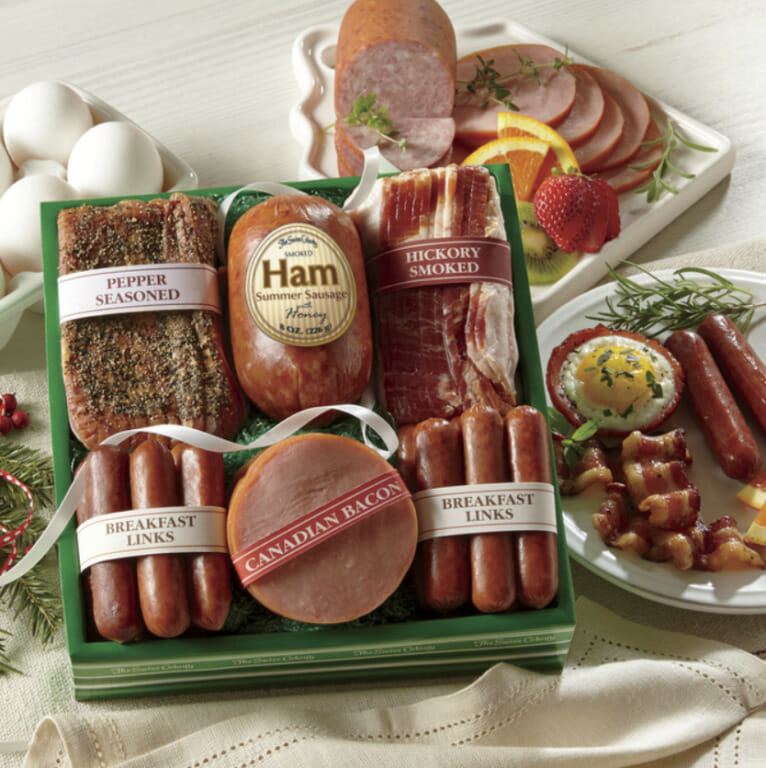Aged Beef at Home: More Tender, More Flavorful
Ever wonder why your steaks at home don’t taste as great as those at the expensive steakhouse? The secret is aging…and now you can buy aged beef online.
The bone-in rib-eye steak arrives, sizzling, to your table in your favorite restaurant. A blackened sear and mouthwatering aroma combine to create a sensory first impression that promises greater things to come…and what follows does not disappoint.

The first thing you notice is a velvety tenderness that you just know should not come from a muscle this large, from a 1,200-pound beast that could destroy your car. Suddenly your taste buds are bathed in a complex blend of flavors: an initial savory hit caused by the Maillard reaction on the outside of the meat giving way to the inside’s juicy sweetness with a mysteriously tangy accent. And as you close your eyes and savor this moment of bliss, you ask yourself: “Why don’t my steaks at home ever taste this good?”
It’s because your favorite restaurant has something your supermarket doesn’t: aged beef.
Aging Meat…Isn’t That a Little Odd?
It may sound unsettling or even dangerous to someone who was taught to always eat fresh food, but properly aged beef is truly something to be experienced. And the science backs it up.
For starters, the key phrase is properly aged. This is a delicate process that should be handled by those who know what they’re doing in a USDA-inspected and -certified facility. Food safety is not to be taken lightly, and poorly handled aging is a great recipe for a trip to the hospital.
The meat you buy at the supermarket is fresh. The long chains of proteins in the muscle tissue are intact…and pretty chewy, and bland in flavor compared to what could be. But that’s where natural chemistry comes in—specifically, the actions of enzymes on proteins. As the meat rests, enzymes that were contained in the muscles’ cells are unleashed and break down those long-chain proteins into amino acids, including the ones that create the savory “fifth flavor” known as umami (think soy sauce or Parmesan cheese). They also convert the small amounts of carbohydrates in the meat into sugars, creating a sweeter taste. And by weakening the connective tissue surrounding the strands of protein, they naturally tenderize the meat without the use of chemical additives.
The trouble is, this process all takes time…and time, as they say, is money. Suppliers want to get paid, and the supermarket needs to sell its product to meet its overhead. It costs a lot of money for a supermarket to sit on all that inventory—not to mention the investment of time, and cooler space, and paying qualified staff to monitor the aging process and protect the investment.
Meanwhile, the fancy restaurant is buying steak from a commercial supplier that takes the time to age their beef for optimum tenderness and flavor. They’re less concerned about cost because their markup to the consumer is higher; while the grocer is selling that 10-ounce rib eye steak for $7.49, the restaurant is charging $40. If they sold you a cheaper steak, it would be no better than what you can cook at home. They need to create that special experience that can only come from a properly aged steak.
Dry Aged vs. Wet Aged
There are two ways to age beef: dry and wet.
Dry aging is the practice of hanging an entire beef, side of beef or certain primal cuts (e.g. rib, loin) in a controlled, refrigerated environment for several weeks. The temperature must remain between 32 and 36 degrees F. Too warm, and the meat will spoil; too cold, and the meat will freeze, halting the aging process. Humidity is tightly regulated, and there must be constant circulation of air.
In addition to the tenderizing and flavor-enhancing effects created by the meat’s natural enzymes, the dry aging process promotes the growth of certain mold species on the meat’s surface. The molds produce enzymes of their own which contribute to flavor and tenderness…and while actually seeing this process could be a little disturbing, the growth is dutifully scraped off before the beef is sold.
The time investment and space required to dry age beef makes it expensive, of course…but it’s the loss of water weight that puts it over the top. Dry-aged beef can lose 30% of its weight by water loss; while this concentrates the “beefy” flavors, it also makes each cut weigh less. That 10-ounce rib eye steak now weighs only 7 ounces, yet the supplier must still sell it based on its original weight…and still factor in the cost of aging. Or, to look at it another way, a 10-ounce dry-aged rib eye once represented 14 ounces of the original rib roast, meaning the supplier gets fewer steaks out of a rib section. That’s why, some 30 years ago, the meat industry developed a new—and less expensive—way of aging beef…
Wet aging consists of vacuum packing beef—either primal or sub-primal cuts—in plastic (cryovac) and letting it age in a refrigerator. The meat is packed in its own juices, allowing its natural enzymes to break down connective issues…but without the fluid loss or mold growth of dry aging. Of course, there’s a tradeoff: you won’t get the concentration of flavors caused by the reduction of water weight or the added funky flavor created by the mold, but the beef retains its original weight (and its value), and the flavor and tenderness are still greatly improved. No wonder wet aging has become the dominant method by far, representing upwards of 90% of aged beef in the U.S. In fact, if a meat supplier does not specify “dry aged,” you can assume the beef is wet aged. Any supplier going to the expense and risk of dry aging is going to make sure you know about it.
Not that there is anything wrong with wet aging at all; in fact, not all steaks can be dry aged. Dry aging only works for cuts of meat that have a protective fat or bone layer, like the rib or loin. Chuck tenders and flat iron steaks are small, tender muscles hidden within the otherwise tough chuck, or shoulder. A meat supplier is not likely to invest the time and cooler space to dry age a huge beef chuck mostly destined for the meat grinder, just to enhance the flavor of a few prized morsels. Yet once these smaller cuts—or singular pieces like skirt or hanger steaks—are removed from the carcass, they simply dry out and otherwise degrade. These steaks are clearly better candidates for wet aging.

I Want to Buy Aged Beef Online…Which Do I Choose?
As with most issues concerning taste, the answer is subjective. Dry aging has become all the rage at trendy, high-end restaurants, with some brave souls pushing the envelope far beyond the traditional 21-day age…to 120 days or even more. And then there are those who are understandably put off by the thought of eating a hunk of meat that recently had fuzz growing on it.
Some people claim there is a difference in flavor; dry-aged beef is generally described as having more of a nutty flavor with Cheddar and/or blue cheese notes, while wet-aged beef is said to have more of a tang. According to an industry report prepared for the National Cattlemen’s Beef Association, some studies have supported these beliefs while others have found no flavor improvement for dry vs. wet-aged beef. Tenderness studies cited in the same report have shown minimal differences for most cuts, with wet-aged bone-in rib-eyes scoring significantly better on tenderness than dry-aged.
Flavor and tenderness preferences aside, the aged beef you prefer will likely be determined by your food budget.



